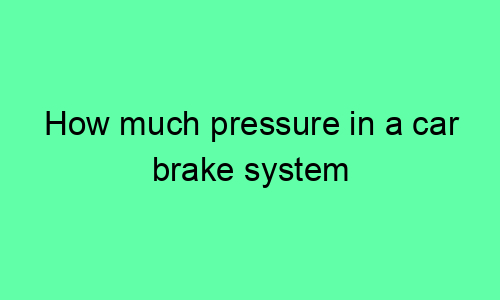## How Much Pressure in a Car Brake System?
### Introduction
The brake system in a car is a crucial safety feature that allows drivers to control and stop the vehicle. At the heart of this system is hydraulic pressure, which transmits force from the brake pedal to the wheel brakes. Understanding the amount of pressure in a car brake system is essential for ensuring optimal performance and safety.
### Brake System Components
The car brake system consists of several key components:
– **Brake Pedal:** The primary control that initiates the braking process when depressed.
– **Brake Master Cylinder:** Converts the force applied to the pedal into hydraulic pressure.
– **Brake Lines:** Pipes that carry the hydraulic fluid from the master cylinder to the wheel brakes.
– **Brake Calipers / Wheel Cylinders:** Mechanical devices that convert hydraulic pressure into mechanical force to engage the brake pads.
– **Brake Pads / Shoes:** Friction materials that create friction with the brake rotors / drums to slow down the vehicle.
### Hydraulic Pressure in the Brake System
The brake master cylinder, located in the engine compartment, is the central hub for hydraulic pressure in the brake system. When the brake pedal is depressed, a piston in the master cylinder pressurizes the brake fluid, which is transmitted through the brake lines to the wheel brakes.
### Pressure Range
The hydraulic pressure in a car brake system typically ranges from:
– **1,000 to 1,500 psi (pounds per square inch)** for passenger cars
– **2,000 to 3,000 psi** for larger vehicles, such as trucks and SUVs
### Relationship between Pressure and Braking Force
The amount of braking force generated is directly proportional to the hydraulic pressure in the brake system. Higher pressure results in greater clamping force on the brake pads, leading to stronger braking.
### Pressure Regulation
To ensure optimal braking performance and prevent excessive brake wear, the pressure in the brake system is regulated by:
– **Brake Pressure Regulator:** Limits the maximum pressure by diverting excess fluid back to the reservoir.
– **Brake Booster:** Amplifies the force applied to the brake pedal, reducing the effort required by the driver.
### Effects of Low or Excessive Pressure
**Low Pressure:**
– Reduced braking force
– Increased pedal travel
– Spongy brake feel
**Excessive Pressure:**
– Overheating of brake components
– Premature brake pad wear
– Loss of brake control
### Factors Affecting Pressure
The following factors can influence the pressure in a car brake system:
– **Brake Pad Thickness:** Worn brake pads reduce the system’s capacity, leading to lower pressure.
– **Age and Condition of Brake Components:** Aging and wear can compromise the seals and connections, resulting in pressure leaks.
– **Air in the System:** Air bubbles in the hydraulic lines can reduce pressure and create a spongy brake feel.
### Consequences of Insufficient Pressure
Insufficient pressure in the brake system can lead to several consequences:
– **Reduced Braking Performance:** The vehicle will take longer to stop and exhibit reduced braking effectiveness.
– **Increased Stopping Distance:** The distance required to bring the vehicle to a complete stop will increase.
– **Safety Concerns:** Compromised braking can pose a serious safety risk.
### Maintenance and Troubleshooting
Regular maintenance is crucial to ensure optimal brake system performance and prevent pressure-related issues. This includes:
– **Brake Fluid Flush and Replacement:** Replacing old brake fluid removes contaminants and maintains system integrity.
– **Brake Pad Inspection and Replacement:** Worn pads should be replaced to restore full braking capacity.
– **Brake Line Inspection and Repair:** Inspect lines for leaks, corrosion, or damage and replace as needed.
If you experience any signs of brake pressure issues, such as a spongy pedal, extended stopping distances, or uneven brake wear, it is recommended to have the brake system inspected and serviced by a qualified mechanic as soon as possible.
### Conclusion
Hydraulic pressure is a critical component of a car brake system, allowing for efficient transmission of force from the pedal to the wheels. Understanding the amount of pressure in the system is essential for ensuring optimal braking performance and safety. Regular maintenance and prompt attention to any pressure-related issues can help prevent potential problems and ensure the continued reliability of your vehicle’s braking capabilities.






